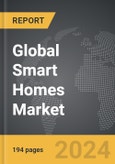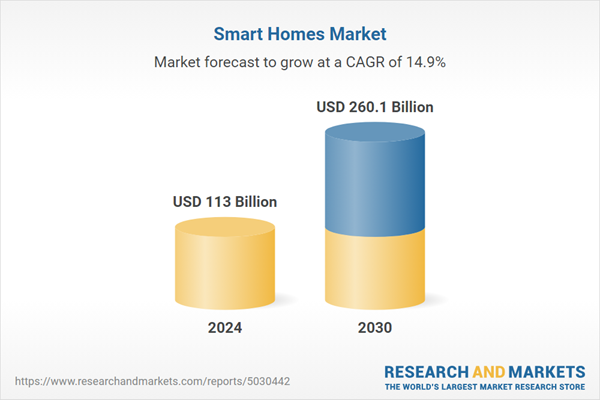The global market for Smart Homes was valued at US$113.0 Billion in 2024 and is projected to reach US$260.1 Billion by 2030, growing at a CAGR of 14.9% from 2024 to 2030. This comprehensive report provides an in-depth analysis of market trends, drivers, and forecasts, helping you make informed business decisions. The report includes the most recent global tariff developments and how they impact the Smart Homes market.
Segments: Product Type (Security & Access Control, Lighting Control, HVAC Control, Entertainment Devices Control, Home Appliances, Smart Kitchen Appliances, Other Product Types); Application (Retrofit Application, New Application).
Geographic Regions/Countries: World; United States; Canada; Japan; China; Europe (France; Germany; Italy; United Kingdom; and Rest of Europe); Asia-Pacific; Rest of World.
The analysts continuously track trade developments worldwide, drawing insights from leading global economists and over 200 industry and policy institutions, including think tanks, trade organizations, and national economic advisory bodies. This intelligence is integrated into forecasting models to provide timely, data-driven analysis of emerging risks and opportunities.
Global Smart Homes Market - Key Trends and Drivers Summarized
Smart Homes: Transforming Living Spaces with Intelligent Connectivity
Smart homes are revolutionizing modern living by integrating intelligent devices and systems that enhance convenience, security, energy efficiency, and overall quality of life. These homes are equipped with IoT-enabled devices such as smart lights, thermostats, locks, cameras, and appliances that can be controlled remotely via smartphones or voice commands. The seamless interoperability of these devices allows users to automate various home functions, such as adjusting lighting and temperature, locking doors, and managing energy consumption. The increasing availability of smart home kits and DIY solutions has made it easier for consumers to retrofit existing homes with smart technologies, thus broadening the market reach.What Role Do Emerging Technologies Play in the Smart Home Ecosystem?
Emerging technologies such as artificial intelligence (AI), machine learning, and 5G connectivity are at the forefront of the smart home market, driving innovation and enhancing user experience. AI-powered virtual assistants like Amazon Alexa, Google Assistant, and Apple Siri provide centralized control over smart home devices, enabling voice-activated commands and personalized recommendations. Machine learning algorithms analyze user behavior to automate routines and improve energy management. Meanwhile, 5G and Wi-Fi 6 technologies provide faster, more reliable connectivity, ensuring seamless communication between devices. The development of edge computing and data analytics further enhances the security and efficiency of smart home networks by reducing latency and optimizing device performance.Which Market Segments Are Dominating the Smart Home Market?
Product types include lighting controls, smart appliances, home automation systems, security systems, and HVAC control, among others with lighting controls & security and surveillance systems holding a significant share due to rising concerns about home safety. Applications range from residential and commercial to government facilities, with residential applications leading the market due to the increasing adoption of smart technologies in households. Distribution channels are divided into online and offline, with online channels expected to dominate in the future due to the convenience and variety of offerings. Geographically, North America leads the market due to high consumer awareness and disposable income, while the Asia-Pacific region is expected to see rapid growth driven by urbanization, rising middle-class income, and smart city initiatives.What Factors Are Driving Growth in the Smart Homes Market?
The growth in the smart homes market is driven by several factors, including the increasing penetration of IoT and connected devices, advancements in AI and machine learning, and growing consumer demand for energy-efficient and secure living spaces. The expansion of smart city projects, rising disposable incomes, and the availability of cost-effective, DIY smart home solutions are also fueling market growth. Furthermore, the growing trend of work-from-home, the development of multi-functional smart home devices, and strategic partnerships between tech companies and real estate developers are contributing to the rapid adoption of smart home technologies.Report Scope
The report analyzes the Smart Homes market, presented in terms of units. The analysis covers the key segments and geographic regions outlined below.Segments: Product Type (Security & Access Control, Lighting Control, HVAC Control, Entertainment Devices Control, Home Appliances, Smart Kitchen Appliances, Other Product Types); Application (Retrofit Application, New Application).
Geographic Regions/Countries: World; United States; Canada; Japan; China; Europe (France; Germany; Italy; United Kingdom; and Rest of Europe); Asia-Pacific; Rest of World.
Key Insights:
- Market Growth: Understand the significant growth trajectory of the Security & Access Control segment, which is expected to reach US$97.1 Billion by 2030 with a CAGR of a 17.5%. The Lighting Control segment is also set to grow at 14.1% CAGR over the analysis period.
- Regional Analysis: Gain insights into the U.S. market, valued at $30.1 Billion in 2024, and China, forecasted to grow at an impressive 13.8% CAGR to reach $39.4 Billion by 2030. Discover growth trends in other key regions, including Japan, Canada, Germany, and the Asia-Pacific.
Why You Should Buy This Report:
- Detailed Market Analysis: Access a thorough analysis of the Global Smart Homes Market, covering all major geographic regions and market segments.
- Competitive Insights: Get an overview of the competitive landscape, including the market presence of major players across different geographies.
- Future Trends and Drivers: Understand the key trends and drivers shaping the future of the Global Smart Homes Market.
- Actionable Insights: Benefit from actionable insights that can help you identify new revenue opportunities and make strategic business decisions.
Key Questions Answered:
- How is the Global Smart Homes Market expected to evolve by 2030?
- What are the main drivers and restraints affecting the market?
- Which market segments will grow the most over the forecast period?
- How will market shares for different regions and segments change by 2030?
- Who are the leading players in the market, and what are their prospects?
Report Features:
- Comprehensive Market Data: Independent analysis of annual sales and market forecasts in US$ Million from 2024 to 2030.
- In-Depth Regional Analysis: Detailed insights into key markets, including the U.S., China, Japan, Canada, Europe, Asia-Pacific, Latin America, Middle East, and Africa.
- Company Profiles: Coverage of players such as Cisco Systems, Inc., Control4 Corporation, Cortexa Automation, LLC, Crestron Electronics, Inc., Emersion Electric Co. and more.
- Complimentary Updates: Receive free report updates for one year to keep you informed of the latest market developments.
Some of the 42 companies featured in this Smart Homes market report include:
- Cisco Systems, Inc.
- Control4 Corporation
- Cortexa Automation, LLC
- Crestron Electronics, Inc.
- Emersion Electric Co.
- FortrezZ
- Guardian Protection Services, Inc.
- Home Automated Living, Inc.
- Honeywell International, Inc.
- Lutron Electronics Co., Inc.
- Monster, Inc.
- Savant Systems LLC
- Simply Automated Incorporated
- Smarthome, Inc.
- United Technologies Corporation (UTC)
- Universal Devices, Inc.
- Vivint, Inc.
Tariff Impact Analysis: Key Insights for 2025
Global tariff negotiations across 180+ countries are reshaping supply chains, costs, and competitiveness. This report reflects the latest developments as of April 2025 and incorporates forward-looking insights into the market outlook.The analysts continuously track trade developments worldwide, drawing insights from leading global economists and over 200 industry and policy institutions, including think tanks, trade organizations, and national economic advisory bodies. This intelligence is integrated into forecasting models to provide timely, data-driven analysis of emerging risks and opportunities.
What’s Included in This Edition:
- Tariff-adjusted market forecasts by region and segment
- Analysis of cost and supply chain implications by sourcing and trade exposure
- Strategic insights into geographic shifts
Buyers receive a free July 2025 update with:
- Finalized tariff impacts and new trade agreement effects
- Updated projections reflecting global sourcing and cost shifts
- Expanded country-specific coverage across the industry
Table of Contents
I. METHODOLOGYII. EXECUTIVE SUMMARY2. FOCUS ON SELECT PLAYERSIII. MARKET ANALYSISIV. COMPETITION
1. MARKET OVERVIEW
3. MARKET TRENDS & DRIVERS
4. GLOBAL MARKET PERSPECTIVE
UNITED STATES
CANADA
JAPAN
CHINA
EUROPE
FRANCE
GERMANY
ITALY
UNITED KINGDOM
REST OF EUROPE
ASIA-PACIFIC
REST OF WORLD
Companies Mentioned (Partial List)
A selection of companies mentioned in this report includes, but is not limited to:
- Cisco Systems, Inc.
- Control4 Corporation
- Cortexa Automation, LLC
- Crestron Electronics, Inc.
- Emersion Electric Co.
- FortrezZ
- Guardian Protection Services, Inc.
- Home Automated Living, Inc.
- Honeywell International, Inc.
- Lutron Electronics Co., Inc.
- Monster, Inc.
- Savant Systems LLC
- Simply Automated Incorporated
- Smarthome, Inc.
- United Technologies Corporation (UTC)
- Universal Devices, Inc.
- Vivint, Inc.
Table Information
| Report Attribute | Details |
|---|---|
| No. of Pages | 194 |
| Published | April 2025 |
| Forecast Period | 2024 - 2030 |
| Estimated Market Value ( USD | $ 113 Billion |
| Forecasted Market Value ( USD | $ 260.1 Billion |
| Compound Annual Growth Rate | 14.9% |
| Regions Covered | Global |






![Smart Home Market: Trends, Opportunities and Competitive Analysis [2024-2030] - Product Image](http://www.researchandmarkets.com/product_images/12658/12658618_60px_jpg/smart_home_market.jpg)


